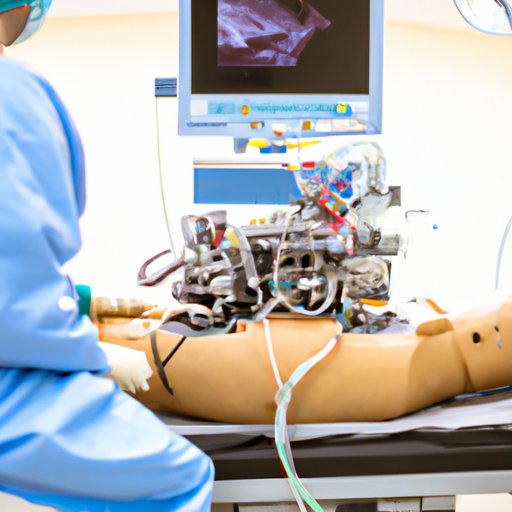Introduction
Robotic surgery is a form of minimally invasive surgery in which the surgeon uses a robotic system to perform operations with greater precision and control than traditional surgical techniques. The use of robotic technology in medical procedures has become increasingly popular in recent years, as it offers many advantages over traditional methods. In this article, we will explore how robotic surgery works, its benefits and risks, and the latest research and developments in this field.

Benefits and Risks of Robotic Surgery
Robotic surgery offers several potential benefits when compared with traditional open surgery. According to a study by the American College of Surgeons (ACS), robotic surgery can result in smaller incisions, less pain, fewer complications, shorter hospital stays, and quicker recovery times than traditional surgeries. In addition, robotic surgery can provide surgeons with more precise control during delicate procedures, resulting in better outcomes for patients.
However, there are also some potential risks associated with robotic surgery. These include the risk of infection due to the use of robotic arms and instruments, as well as the possibility of mechanical failure or human error. In addition, the cost of robotic surgery can be higher than traditional surgery, although this may be offset by the shorter hospital stays and faster recovery times.

Types of Procedures Performed by Robotic Surgery
Robotic surgery can be used for a variety of procedures, including cardiac surgery, gynecologic surgery, urologic surgery, and general surgery. It can also be used to perform other procedures, such as bariatric surgery, ear, nose, and throat surgery, and orthopedic surgery.
Cardiac surgeons often use robotic surgery to perform coronary artery bypass grafting (CABG) and valve repair and replacement. Gynecologic surgeons may use robotic surgery to perform hysterectomies and myomectomies. Urologists may use robotic surgery to perform prostatectomies and nephrectomies. General surgeons may use robotic surgery to perform gastric bypass, hernia repairs, and colorectal resections.
The Role of the Surgeon in a Robotic Surgery Procedure
The surgeon plays an important role in a robotic surgery procedure. Before the operation, the surgeon must prepare the patient for the procedure and plan the best approach to achieve the desired outcome. During the operation, the surgeon will use the robotic technology to control the instruments, allowing for greater accuracy and precision.
After the operation, the surgeon will monitor the patient’s recovery and provide post-operative care as needed. The surgeon will also review the results of the procedure and make any necessary adjustments to ensure the best possible outcome.
Latest Research and Developments in Robotic Surgery
In recent years, there have been significant advances in robotic surgery technology. According to a study published in the journal Surgical Endoscopy, researchers have developed new technologies that allow for greater accuracy and precision during robotic surgery procedures. For example, new imaging systems can provide surgeons with real-time information on tissue structure and movement, allowing them to make more informed decisions during the procedure.
In addition, new techniques such as 3D printing and haptic feedback can provide surgeons with tactile information about the tissue they are operating on. This allows them to make more precise movements, resulting in better outcomes for patients.

Patient Experience of Robotic Surgery
Robotic surgery offers many advantages for patients, but it is important to consider the potential risks and side effects before undergoing the procedure. Patients should discuss the benefits and risks of robotic surgery with their doctor, as well as any pre-operative considerations, such as diet and exercise. During the procedure, patients may experience some discomfort, but the surgeon will take steps to minimize this.
Following the operation, patients may need to stay in the hospital for a few days for observation and recovery. After discharge, patients will need to follow-up with their doctor for regular check-ups. They may also need to make lifestyle changes, such as exercising regularly and eating a healthy diet, to maximize the benefits of their surgery.
Conclusion
Robotic surgery is an advanced form of minimally invasive surgery that offers numerous advantages for patients. It can result in smaller incisions, less pain, fewer complications, shorter hospital stays, and quicker recovery times than traditional surgeries. In addition, robotic surgery provides surgeons with greater accuracy and precision during delicate procedures, resulting in better outcomes for patients.
There are also some potential risks associated with robotic surgery, such as the risk of infection and mechanical failure. Patients should discuss the benefits and risks of robotic surgery with their doctor before undergoing the procedure. The latest research and developments in robotic surgery have resulted in improvements in accuracy and precision, as well as new techniques and technologies.
(Note: Is this article not meeting your expectations? Do you have knowledge or insights to share? Unlock new opportunities and expand your reach by joining our authors team. Click Registration to join us and share your expertise with our readers.)
